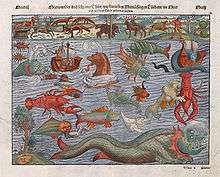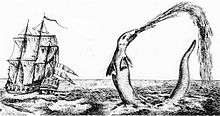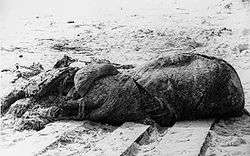Sea monster

Sea monsters are beings from folklore believed to dwell in the sea and often imagined to be of immense size. Marine monsters can take many forms, including sea dragons, sea serpents, or multi-armed beasts. They can be slimy and scaly and are often pictured threatening ships or spouting jets of water. The definition of a "monster" is subjective, and some sea monsters may have been based on scientifically accepted creatures such as whales and types of giant and colossal squid.
Sightings and legends

Historically, decorative drawings of heraldic dolphins and sea monsters were frequently used to illustrate maps, such as the Carta marina. This practice died away with the advent of modern cartography. Nevertheless, stories of sea monsters and eyewitness accounts which claim to have seen these beasts persist to this day.

Sea monster accounts are found in virtually all cultures that have contact with the sea. For example, Avienus relates of Carthaginian explorer Himilco's voyage "...there monsters of the deep, and beasts swim amid the slow and sluggishly crawling ships." (lines 117-29 of Ora Maritima). Sir Humphrey Gilbert claimed to have encountered a lion-like monster with "glaring eyes" on his return voyage after formally claiming St. John's, Newfoundland (1583) for England.[1] Another account of an encounter with a sea monster comes from July 1734. Hans Egede, a Dano-Norwegian missionary, reported that on a voyage to Gothaab/Nuuk on the western coast of Greenland he observed:[2]
a most terrible creature, resembling nothing they saw before. The monster lifted its head so high that it seemed to be higher than the crow's nest on the mainmast. The head was small and the body short and wrinkled. The unknown creature was using giant fins which propelled it through the water. Later the sailors saw its tail as well. The monster was longer than our whole ship.
Other reports are known from the Pacific, Indian and Southern Oceans (e.g. see Heuvelmans 1968).
There is a Tlingit legend about a sea monster named Gunakadeit (Goo-na'-ka-date) who brought prosperity and good luck to a village in crisis, people starving in the home they made for themselves on the southeastern coast of Alaska.
Ellis (1999) suggested the Egede monster might have been a giant squid. Other hypotheses are that modern-day monsters are surviving specimens of giant marine reptiles, such as an ichthyosaur or plesiosaur, from the Jurassic and Cretaceous Periods, or extinct whales like Basilosaurus. Ship damage from Tropical cyclones such as hurricanes or typhoons may also be another possible origin of sea monsters.
In 1892, Anthonie Cornelis Oudemans, then director of the Royal Zoological Gardens at The Hague saw the publication of his The Great Sea Serpent, which suggested that many sea serpent reports were best accounted for as a previously unknown giant, long-necked pinniped.
It is likely that many other reports of sea monsters are misinterpreted sightings of shark and whale carcasses (see below), floating kelp, logs or other flotsam such as abandoned rafts, canoes and fishing nets.
Alleged sea monster carcasses

Sea monster corpses have been reported since recent antiquity (Heuvelmans 1968). Unidentified carcasses are often called globsters. The alleged plesiosaur netted by the Japanese trawler Zuiyō Maru off New Zealand caused a sensation in 1977 and was immortalized on a Brazilian postage stamp before it was suggested by the FBI to be the decomposing carcass of a basking shark. Likewise, DNA testing confirmed that an alleged sea monster washed up on, Newfoundland in August 2001, was a sperm whale.[3]
Another modern example of a "sea monster" was the strange creature washed up in Los Muermos on the Chilean sea shore in July 2003. It was first described as a "mammoth jellyfish as long as a bus" but was later determined to be another corpse of a sperm whale. Cases of boneless, amorphic globsters are sometimes believed to be gigantic octopuses, but it has now been determined that sperm whales dying at sea decompose in such a way that the blubber detaches from the body, forming featureless whitish masses that sometimes exhibit a hairy texture due to exposed strands of collagen fibers. The analysis of the Zuiyō Maru carcass revealed a comparable phenomenon in decomposing basking shark carcasses, which lose most of the lower head area and the dorsal and caudal fins first, making them resemble a plesiosaur.
Examples
- Aspidochelone, a giant turtle or whale that appeared to be an island and lured sailors to their doom
- Bakunawa
- Capricorn, Babylonian Water-Goat featured in the Zodiac
- Cetus, a monster sent by Poseidon to devour Andromeda, only to be destroyed by Perseus
- Charybdis of Homer, a monstrous whirlpool that sucked any ship nearby beneath the ocean
- Cirein-cròin
- Coinchenn, from whose bone the Gae Bulg is made in Celtic mythology
- The Devil Whale, a demonic whale the size of an island
- Hydra, Greek multi-headed dragon
- Iku-Turso, reputedly a type of colossal octopus or walrus
- Jörmungandr, the Midgard Serpent in Norse mythology
- Kraken, a gigantic octopus, squid, or crab-like creature
- Lacovie
- Makara
- Nessie, also known as the Loch Ness Monster
- Proteus
- Scylla of Homer, a six-headed, twelve-legged serpentine that devoured six men from each ship that passed by
- Sirens
- Taniwha
- The Rainbow Fish
- Tiamat
- Timingila
- Umibōzu
- Yacumama
Historically reported sea monsters
Sea monsters actually reported first or second hand include
- A giant octopus by Pliny (not to be confused with the documented giant Pacific octopus)
- Leviathan
- Cecaelias or Octopus people
- Sea monk
- Various sea serpents
- Tritons by Pliny
- Cormac Ua Liatháin in the 6th century supposedly saw a horde of tiny creatures the size of frogs that had spines, which attacked his boat in the North Atlantic according to an account written by Adomnan of Iona[4]
Currently reported specific sea monsters
- Ayia Napa Sea Monster, of Ayia Napa, Cyprus
- Cadborosaurus of the Pacific Northwest
- Champ of Lake Champlain
- Chessie of the Chesapeake Bay
- Nessie of Loch Ness
- Issie of Lake Ikeda, Kyushu
- Ogopogo of Okanagan Lake
- Lusca
- Morgawr
- Ningen, a humanoid creature sighted in the seas north of Japan[5]
- Shore Laddie Arnarfjörður, Westfjords, Iceland
- Sea Horse Arnarfjörður, Westfjords, Iceland
- The Shell monster Arnarfjörður, Westfjords, Iceland
- Merman Arnarfjörður, Westfjords, Iceland
In fiction
- Creatures of H. P. Lovecraft's Cthulhu Mythos, including Cthulhu itself.
- Creatures in such sci-fi/horror films as Deepstar Six, The Rift, Deep Rising and Deep Shock.
- Clover
- Cyrus from Cyrus the Unsinkable Sea Serpent by Bill Peet
- Fictional portrayals of the Giant Squid, like Twenty Thousand Leagues Under the Sea.
- Giant octopus in It Came from Beneath the Sea.
- Giganto
- Godzilla
- Gorgo
- Manda
- Kraken as depicted in Clash of the Titans (both the 1981 and 2010 versions).
- Kraken as depicted in Pirates of the Caribbean: Dead Man's Chest.
- Ebirah
- Titanosaurus
- Zigra
- Moby Dick
- Rhedosaurus
- The Terrible Dogfish
- Jaws
- Sigmund and the Sea Monsters
See also
References
- ↑ Edward Haies: Sir Humphrey Gilbert's Voyage To Newfoundland, 1583 In the fifth section after the notice "Footnote 11: Stephen Parmenius"
- ↑ J. Mareš, Svět tajemných zvířat, Prague, 1997
- ↑ Carr, S.M., H.D. Marshall, K.A. Johnstone, L.M. Pynn & G.B. Stenson 2002. How To Tell a Sea Monster: Molecular Discrimination of Large Marine Animals of the North Atlantic. Biological Bulletin 202: 1-5.
- ↑ Adomnan of Iona. Life of St Columba. Penguin books, 1995
- ↑ "ช่วง เด็กพิลึก ตอน นินเจน สัตว์ประหลาดลึกลับใต้ท้องทะเล". BEC-TERO (in Thai). 2015-11-25. Retrieved 2017-06-25.
| Wikimedia Commons has media related to Sea monster. |